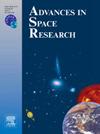航空航天应用激光雷达评估中层大气气候学
IF 2.8
3区 地球科学
Q2 ASTRONOMY & ASTROPHYSICS
引用次数: 0
摘要
本研究利用ERA-5和nrlmsse -2.0模式,通过与我们40年的温度激光雷达观测结果进行比较,评估了平流层上层和中间层的温度和密度变化。nrlmsse -2.0虽然在季节趋势方面是可靠的,但每日的准确性较低:它与高海拔激光雷达显示出很大的偏差(全球范围内,50公里以下小于4 K, 80公里处高达14 K)。欧洲气候和天气预报再分析模式ERA-5显示出对平流层上层-5 K激光雷达的偏差,但在中间层显示出更大的差异,达到+20 K。激光雷达观测可以揭示极端事件的非高斯分布,如中间层逆温层(MILs)、轻微和严重的平流层突然变暖(m-和m- ssws)或双平流层(ds)。这些事件是大气的特殊性,如果目的是创建参考,则不应将其与稳态剖面混合来计算平均气候学。为了解决这个问题,我们开发了一种新的方法来消除这些事件,从而产生了我们所谓的“稳态”气候学。我们的方法基于四个地点(上普罗旺斯天文台、留尼汪岛、桌山和莫纳罗亚)的激光雷达观测,使我们能够提供有关这些极端现象的统计信息。此外,我们的研究结果表明,当m- ssw和mil发生时,密度分布严重偏离NRLMISE-2.0密度,这突出了对航空航天应用的精细大气模型的需求。对于mil和m- ssw, NRLMSISE与激光雷达对应的密度差最大可达- 15%和+25%。本文章由计算机程序翻译,如有差异,请以英文原文为准。
Assessment of middle atmosphere climatology using lidar for aerospace applications
This study evaluates temperature and density variations in the upper stratosphere and in the mesosphere using ERA-5 and NRLMSISE-2.0 models, by comparing them with our forty-years long temperature lidar observations. NRLMSISE-2.0, while reliable in terms of seasonal trends, is less accurate daily: it shows high biases with the lidar at high altitudes (globally less than 4 K below 50 km, up to 14 K at 80 km). The European Climate and Weather Forecast reanalysis model ERA-5 shows a bias to the lidar of −5 K the upper stratosphere but shows a larger difference reaching +20 K in the mesosphere. Lidar observations can reveal non-Gaussian distributions because of extreme events, such as Mesospheric Inversion Layers (MILs), minor and Major Sudden Stratospheric Warmings (m- and M-SSWs) or Double Stratopauses (DSs). These events are atmospheric particularities which should not be mixed with steady-state profiles to compute a mean climatology if the aim is to create a reference. To address this issue, a new methodology was developed to remove those events, resulting in what we called ”Steady-State” climatology. Our method based on lidar observation in four sites (Observatory of Haute-Provence, Reunion Island, Table Mountain and Mauna Loa) allowed us to give statistical information about these extreme phenomena. Furthermore, our findings show that when m-SSWs and MILs occur, the density profile deviates strongly from the NRLMISE-2.0 density, which highlights the need for refined atmospheric models for aerospace applications. Corresponding density differences between NRLMSISE and lidar can reach −15% and +25% at most for MILs and m-SSWs, respectively.
求助全文
通过发布文献求助,成功后即可免费获取论文全文。
去求助
来源期刊

Advances in Space Research
地学天文-地球科学综合
CiteScore
5.20
自引率
11.50%
发文量
800
审稿时长
5.8 months
期刊介绍:
The COSPAR publication Advances in Space Research (ASR) is an open journal covering all areas of space research including: space studies of the Earth''s surface, meteorology, climate, the Earth-Moon system, planets and small bodies of the solar system, upper atmospheres, ionospheres and magnetospheres of the Earth and planets including reference atmospheres, space plasmas in the solar system, astrophysics from space, materials sciences in space, fundamental physics in space, space debris, space weather, Earth observations of space phenomena, etc.
NB: Please note that manuscripts related to life sciences as related to space are no more accepted for submission to Advances in Space Research. Such manuscripts should now be submitted to the new COSPAR Journal Life Sciences in Space Research (LSSR).
All submissions are reviewed by two scientists in the field. COSPAR is an interdisciplinary scientific organization concerned with the progress of space research on an international scale. Operating under the rules of ICSU, COSPAR ignores political considerations and considers all questions solely from the scientific viewpoint.
 求助内容:
求助内容: 应助结果提醒方式:
应助结果提醒方式:


